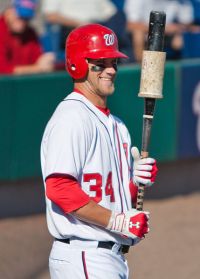Following an exciting and successful World Baseball Classic in which the relatively boring United States team came out victorious, the question of how to make MLB more interesting has resurfaced. Those who watched the recently finished tournament noticed how much fun the players on many teams, including Puerto Rico and the Dominican Republic were having. While a majority of fans, especially casual ones, enjoyed the energetic and spontaneous enthusiasm of Latino teams, the old guard preferred the stuck up, conventional style of the U.S. team. This conflict in how fans prefer to watch their games is an important study to conduct if Major League Baseball wants to grow their fan base.
Early in 2016, young star and 2015 MVP Bryce Harper donned a “Make Baseball Fun Again” hat while talking to the media by his locker following a game. The cap, which was modeled after Donald Trump’s “Make America Great Again” garb, speaks to a divide in baseball fans that is almost as entrenched in cultural differences as the country’s political climate. Bryce Harper, Yoenis Cespedes and plenty of other major leaguers are fine with bat flips, but guys like Ian Kinsler take the great game of baseball and all of its conventions too seriously.
During the 2015 ALDS, Jose Bautista launched a big fly and celebrated with a spur of the moment bat flip. The opposing Texas Rangers team and much of the baseball world scorned Bautsista who went on to receive unnecessary retaliation. Before the final of the WBC, second baseman Kinsler responded to the emotional reactions of Latino players compared to the subdued and boring style of play shown by Americans.
“They were raised differently and to show emotion and passion when you play,” Kinsler said. “We do show emotion; we do show passion. But we just do it in a different way.”
Commissioner Rob Manfred is well aware of the dangerous dichotomy that is restricting growth in baseball’s popularity. Since Manfred took over the reins in 2015, there have certainly been attempts t bring in a more casual, youthful audience. Instant replay has expanded but complaints about length and pace of games has persisted. Pitchers now must follow a strict pitch clock and intentional walks can be doled out by a signal from a team’s manager. These rule changes provide marginal benefit in speeding up action during games but do nothing to solve the fun problem.
Manfred has said that bat flips are good for the game and encourages players to show their energy on the diamond. While the league can’t force players to perform a Fernando Rodney-like dance after each clutch moment, there are efforts MLB can make that will satisfy loyal fans while attracting more would be spectators. However, expansion is not one of those options.
MLB most recently added teams to the league in 1998 when the Tampa Bay Devil Rays and Arizona Diamondbacks brought the total to 30 clubs. Since, the NBA has added a team in New Orleans and is currently looking at further expansion. The NHL has just introduced their fifth new franchise, the Vegas Golden Knights, in that timeframe. The Houston Texans have also joined the NFL. While expansion seems like a reasonable solution to broaden baseball’s fan base, the premise behind it is flawed.
Relocation is a better solution to develop more and better baseball fans. The Tampa Bay Rays, heading into their 20th season of play, haven’t been in the top half of the AL’s attendance since their inaugural season and the Oakland A’s are a pair of teams with weak fanbases. Both teams have dreadful stadiums; Tampa’s Tropicana Field is an eye sore and the O.Co Coliseum has gone through various name changes but is still a third-rate baseball venue. The Rays have been last in American League attendance in four of the last six years, coming in second to last the other two years. Even when they went to the World Series is 2008, the team couldn’t come close to 2 million visitors. The Athletics’ attendance, while not as dreadful, is still embarrassing considering gate numbers when they were repeating division champions.
Montreal lost its team in 2004 and has shown it is ready to get one back. Another international destination for a club would be a perfect way to create more fans, especially coming off the success of the WBC. Mexico City, San Juan and even Havana would all be great options for a MLB team to call home. By relocating poorly placed teams to more exciting locales, MLB will help solve the fun problem and bring more fans to baseball.





